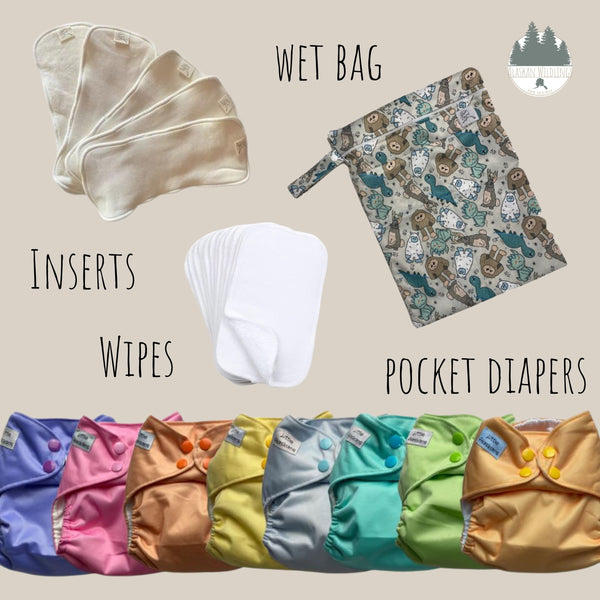
8 Cloth Diaper Myths Debunked
8 Cloth Diaper Myths Debunked
Sometimes the mention of cloth diapers prompts excitement and other times exaggerated eye rolls. If you’re someone in the latter group, you probably recoil at the thought of stinky diapers and extra laundry. You probably think of cloth diapering as a dated practice with little advancement over the years. But, tribe, that’s not true at all! And, we think cloth diapers get a totally bad rap.
Understanding what is not true about cloth diapers will help you make an informed decision on your chosen diapering method. You’ll read below that cloth diapers are not only equal to disposables but better in many ways! (And not just for the environment.)
If you’re not convinced, I get it. But, you’re here. So, you must be curious! Let’s dive into some common cloth diaper myths and preconceived notions. We’ll debunk these and set the record straight on modern cloth diapering. Let’s do it!
8 Cloth Diapering Myths Debunked

#1 Cloth diapering doesn’t actually save you money.
If you search “cloth diapers,” you’ll be overwhelmed by the selection of reusable diapers available. These diapers range from just a few dollars all the way up to $40 a piece. Plus, after you buy your diapers, you’ll need wet bags and wipes too. You might be thinking, this is WAY more expensive than buying a box of disposables!
But, it’s important to think in the long term. Cloth diapering is a higher upfront cost. But, guess what? That's it! One time cost for the whole diapering journey–and for all your little wildlings. Here at Alaskan Wildlings, we offer pocket diapers, which are a mid range price option of cloth diapers. And, they’re some of the easiest to use! Here’s the price comparison for the first year of diapering between the two options:

Cloth Diapers
- 24 Pocket Diapers - $235
- 24 Inserts - $115
- 3 Wet Bags - $25
- 4 Dozen Wipes - $48
- Total: $425
Disposable Diapers
- Disposable Diapers - $1,000
- Wipes - $450
- Total: $1,450
Now, there are a few more factors when it comes to cloth diapering, like detergent and utilities. But, those expenses only add about $200 to the total cost. That still puts cloth diapering not only way under disposables for the first year, but WAY under in the long-term. If you consider multiple years and multiple babies, cloth diapering is a substantial savings over disposable diapers.
#2 Cloth diapers cause developmental delays.
It’s long been said that cloth diapering causes delayed mobility, late walking, and hip issues. These claims are totally unfounded. Think about it. For centuries, all we had were bulky cloth diapers, and everyone learned to roll, crawl, and walk! So, really, the whole notion is silly! Especially when you consider that cloth diapers now are far less bulky than they used to be.
Just like if your baby was in disposables, they may walk late or they may walk early! But the speed of development has nothing to do with cloth. Oh, and it does not make your child more likely to be bow legged or pigeon toed. That’s a total myth.
The only proper study that has been done on diapers and mobility concluded that there was no difference in development between cloth diapers and disposables. It did find that going naked sped up developmental milestones. But, I don’t think anyone here is advocating for that! Let’s keep those diapers on and the floors clean!
#3 Cloth diapers are gross.
Cloth diapers aren’t any grosser than disposables. Let’s not forget we’re talking about mechanisms that catch pee and poop. So, will there be pee and poo? Sure. But, it’s not hard to deal with as long as you’re washing regularly.
If you keep cloth diapers in an open bin with airflow and have a good wash routine, you’ll likely not see or smell anything nasty! Additionally, cloth diapers use fabrics like cotton and athletic wicking jersey that don’t stain easily. So, your diapers will look and smell fresh, just like disposables!
Additionally, if you get rid of that poop fast by spraying, scrubbing, or plopping it into a toilet, you won’t be dealing with any stewing fecal pheromones. (Yuck!) Just like disposables, you don’t want to let dirty diapers sit for a long time or in closed containers. Eventually, they will stink, but there is little difference between disposables and cloth.
#4 Cloth diapers are difficult to use.
Cloth diapers come in lots of varieties! The flour sack towels and rubber pants from the 80s are not your only option. The ease of cloth diapers directly relates to the price. As a general rule, the easier the diaper, the more expensive.
Flat or prefold diapers with a few reusable covers are harder to use as they involve folding and pinning, but come at the lowest price point. All-in-One diapers are the easiest, with the entire diaper as one piece and fasteners that work similarly to a disposable diaper, but they’re pricey! Good midrange options for a pretty easy diapering experience include preflats, pockets, and all-in-twos.
Pocket diapers like we have at Alaskan Wildlings require no folding or difficult sizing! They’re one size fits most and all you have to do is stuff the diaper with its insert after washing. They fasten using snaps, which makes putting the diaper on your little wildling and getting a great fit a breeze. Anyone can figure it out, including you, grandparents, daycare providers, and your husband too.
#6 You can’t use cloth diapers at daycare.
Most states do not have regulations that prohibit cloth diapers from being used in daycare facilities. You can look at your state’s specific diapering policies here. But, likely if you’re getting backlash on cloth diapering at daycare, it’s a center policy and not a health department policy.
This is good news, because it means there are providers out there that will cloth diaper. Just do your research, try to talk to providers in person, and don’t settle for less than what you know is best for your family. At the same time, respect the parameters the providers set for cloth diapering. They may ask you to use disposable liners or provide bags for every soiled diaper. The arrangement will involve some give and take.
Additionally, if your child can’t use disposables due to allergies or sensitive skin, get a doctor’s note to present to your daycare. Most daycares will allow cloth diapering after receiving this from the doctor. If not, start searching for a new place. There are plenty of cloth-diaper friendly daycares out there!
#7 Cloth diapers aren’t good for sensitive skin.
Speaking of allergies and sensitive skin . . . another myth we hear often is that cloth diapers are bad for baby’s skin. At the core, this isn’t true. But, it’s a little more complicated than that. Let us explain!
If you’re currently using disposable diapers, and you’re having lots of issues with diaper rash, blistering, dry skin, and other issues, your little wildling might be allergic to the materials used in disposable diapers (or wipes). Switching to cloth diapers could totally eradicate these issues for you! Many parents report smooth bums with cloth, but harsh rashes with disposables.
That being said, the opposite can be true. Sometimes babies can have sensitivity to wetness, heat, or different fiber types in cloth. When this happens, disposables might be the better choice for your child’s sensitive skin.
The point is, neither cloth nor disposables are inherently bad for a baby’s skin. Each one could be the answer to your problems or the reason for your problems. Do some investigating and experimenting to see if you can diagnose the problem before making a big switch.
#8 Cloth diapers don’t work as well as disposables.
It’s true that cloth diapers must be changed more often than disposable ones. But, this does not mean they don’t work as well! Disposable diapers use a synthetic substance called “sodium polyacrylate” that are synthetic super absorbing crystals that pull moisture away from your little wildling and hold more liquid. Cloth diapers use fabric and natural fibers to absorb liquid, which means the absorbency capacity is limited depending on the materials you use.
So, yes, cloth diapers potentially hold less liquid at the base. But, the beauty of cloth diapers is that they’re infinitely customizable! This means, if you have a boy, you can concentrate more absorbency at the front or if your child is prone to blowouts, you can add extra rolls of protection in the back. If a standard diaper isn’t enough for long nights and naps, you can add additional layers of absorbency.
This makes cloth diapers work better for your child, because they’re tailored specifically to them! And most parents report back fewer blowouts with cloth diapers due to the perfect fit and trusty elastics.
#9 No one cloth diapers anymore.
The cloth diaper industry is growing. More and more moms are making the switch, especially after COVID-19 related shortages and increased awareness about the environmental impacts.
Plus, cloth diapers are fun! Not only is it better for your kiddo and the earth, but cloth diapers are so cute. Many parents love styling cloth diapers with their little wildling’s outfits while saving money and positively impacting the environment. It’s a win-win-win! And more families every day are realizing what cloth diapering could do for their tribe.
Cloth diapers are affordable, sustainable, easy-to-use, cute, and great for sensitive skin!

There are a lot of negative thoughts that come with cloth diapering. But, most of those thoughts don’t come from anyone with any real knowledge or experience. Cloth diapering is an incredible journey that not only is good for the earth, but is good for your family too.
If you think cloth diapers are the right choice for you, follow us on Facebook, Instagram, and TikTok and join our incredible community. Plus, check back for more helpful blog posts. Our tribe is ready to support you through your cloth diapering adventure. This is a choice you won’t regret making. It’ll have a lasting effect on your little wildlings, your family, and our planet.
